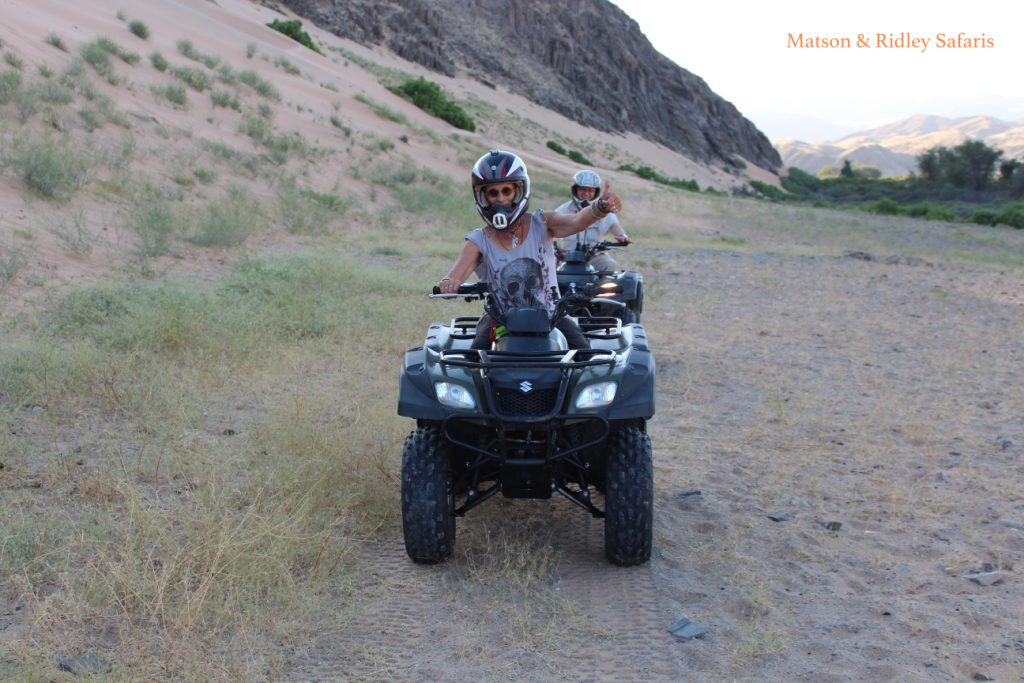There are some parts of Africa that remove you so completely from reality that you start to wonder whether all that stuff that fills your life with worries in the 'outside' world really matters much. Serra Cafema Camp, in the Marienfluss Conservancy, is such a place, where traditional Himba people still live a life that is much like what it was several hundred years ago, where a river teeming with crocodiles slices through gothic mountains surrounded by sand dunes, where you can really find yourself by losing yourself in landscapes so primitive you can't help but feel humbled. There's no phone range or wifi up here so you can leave all that behind. And you know what - you probably won't miss it one bit. It's all about disconnecting to reconnect, as Wilderness Safaris puts it. This is the ultimate escape and a huge adventure.
Here's my photos of one of my favourite parts of truly wild Africa, our escape to the most remote part of the land that God forgot, as promised in last week's blog.
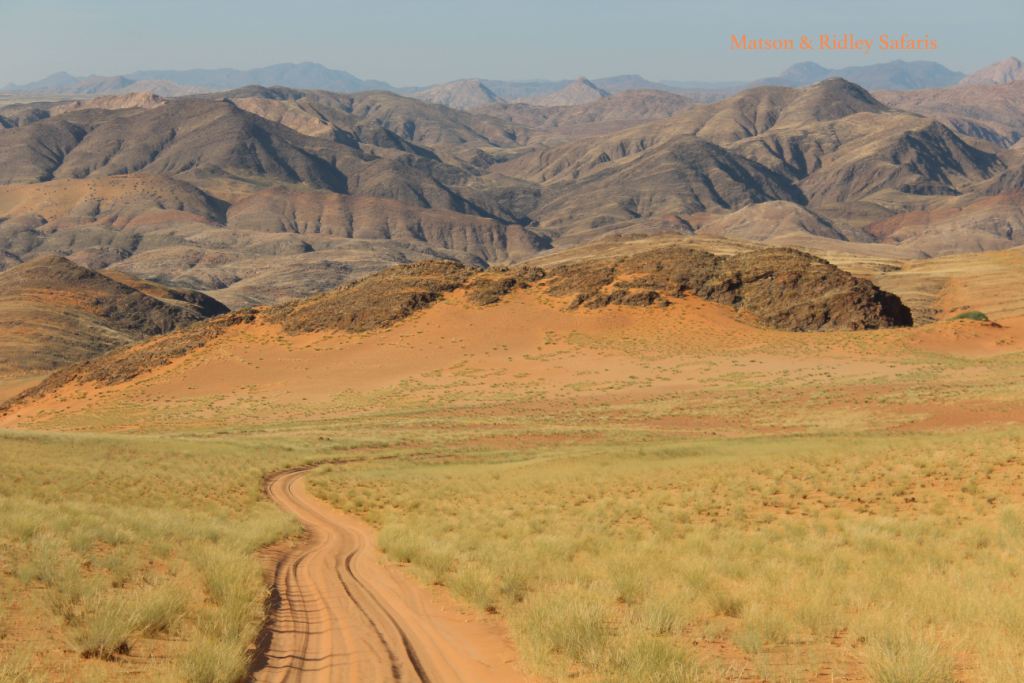 The road to 'never never' in the land that God forgot.... It takes several hours in a light plane to get to Serra Cafema from Namibia's capital city, Windhoek, and then another hour or so to get to the camp itself. They don't call it the most remote camp in southern Africa for no reason. But it's worth it. You can't imagine what it feels like to be in this primeval place with all that space around you without actually going somewhere like this. It's like taking a step back in time and the colours are simply breath-taking.
The road to 'never never' in the land that God forgot.... It takes several hours in a light plane to get to Serra Cafema from Namibia's capital city, Windhoek, and then another hour or so to get to the camp itself. They don't call it the most remote camp in southern Africa for no reason. But it's worth it. You can't imagine what it feels like to be in this primeval place with all that space around you without actually going somewhere like this. It's like taking a step back in time and the colours are simply breath-taking.
 One of the best things about Cafema is that you can walk to your heart's delight. Here's one of our group members, Tristan, on a dawn walk in the dunes up behind camp. There used to be lions and elephants and even rhinos in north west Namibia, but the war up until 1990 when Namibia achieved Independence, wiped them all out. It would be incredible to see these species coming back and with the right ongoing management that is possible. Now the species you're most likely to see in this region are springbok, oryx and ostriches, and for the lucky ones there are also endangered Hartmanns mountain zebras, with their distinctive thin black and white stripes without any shadow stripes. Predators like brown hyaenas and jackals live here too, as testified by their tracks in the sand near camp.
One of the best things about Cafema is that you can walk to your heart's delight. Here's one of our group members, Tristan, on a dawn walk in the dunes up behind camp. There used to be lions and elephants and even rhinos in north west Namibia, but the war up until 1990 when Namibia achieved Independence, wiped them all out. It would be incredible to see these species coming back and with the right ongoing management that is possible. Now the species you're most likely to see in this region are springbok, oryx and ostriches, and for the lucky ones there are also endangered Hartmanns mountain zebras, with their distinctive thin black and white stripes without any shadow stripes. Predators like brown hyaenas and jackals live here too, as testified by their tracks in the sand near camp.
 This is the view of the Kunene River that you get on the deck of the main area at Serra Cafema Camp. The luxurious camp is nestled under big shady Ana and Acacia trees and is truly an oasis in the middle of nowhere. You walk to your room along wooden walk ways on stilts. That's Angola across the river, the Kunene marking the boundary. All day and night you can hear the rapids upstream. The contrast of being in the desert dunes so far from any kind of civilisation with this rushing river that originates in the highlands of central Angola and floods out through the Skeleton Coast to the Atlantic Ocean is mind blowing. But above all, it's incredibly relaxing. A swim in this river is not recommended, and you'll see why if you scroll down....
This is the view of the Kunene River that you get on the deck of the main area at Serra Cafema Camp. The luxurious camp is nestled under big shady Ana and Acacia trees and is truly an oasis in the middle of nowhere. You walk to your room along wooden walk ways on stilts. That's Angola across the river, the Kunene marking the boundary. All day and night you can hear the rapids upstream. The contrast of being in the desert dunes so far from any kind of civilisation with this rushing river that originates in the highlands of central Angola and floods out through the Skeleton Coast to the Atlantic Ocean is mind blowing. But above all, it's incredibly relaxing. A swim in this river is not recommended, and you'll see why if you scroll down....
 Nile crocodile, sun bathing.... One of the most fun activities at Cafema is an afternoon boat ride up the Kunene River, where you have a good chance to see crocs like this guy sunning in the late afternoon, and abundant bird life. Just before the sun sets the guides pull up at a sand bank on the Angolan side and lay out sun downers fit for kings and queens. It's a really tough life!
Nile crocodile, sun bathing.... One of the most fun activities at Cafema is an afternoon boat ride up the Kunene River, where you have a good chance to see crocs like this guy sunning in the late afternoon, and abundant bird life. Just before the sun sets the guides pull up at a sand bank on the Angolan side and lay out sun downers fit for kings and queens. It's a really tough life!
 The '3 Ozzies', Joanne, Maggie and Leonie, watching the rest of our group in the other vehicle come down the dunes on the drive into camp. There are some adrenaline rushes as the 4x4s slide down certain roads on steep dunes, which of course the guides do all the time, but the first time you do it you really wonder if you're going to survive!
The '3 Ozzies', Joanne, Maggie and Leonie, watching the rest of our group in the other vehicle come down the dunes on the drive into camp. There are some adrenaline rushes as the 4x4s slide down certain roads on steep dunes, which of course the guides do all the time, but the first time you do it you really wonder if you're going to survive!
 It hadn't rained in this area for about 5 years, according to our guides, and then 3 months before our visit, the heavens smiled and granted the Hartmanns Valley a generous serve of much needed rain. The result was incredible scenes like this where usually there is only sand, now valleys filled with grass. These ostriches were clearly still celebrating with a large flock of youngsters, taking advantage of the good times to reproduce.
It hadn't rained in this area for about 5 years, according to our guides, and then 3 months before our visit, the heavens smiled and granted the Hartmanns Valley a generous serve of much needed rain. The result was incredible scenes like this where usually there is only sand, now valleys filled with grass. These ostriches were clearly still celebrating with a large flock of youngsters, taking advantage of the good times to reproduce.
 Here we all are having sundowners on the Kunene River with one of our Himba guides, Timo - on the Angolan side without a passport! Back row: Timo, Patricia, Tristan, Carina, Joanne, Leonie, Helen. Front: Chuan Fong, me and Maggie.
Here we all are having sundowners on the Kunene River with one of our Himba guides, Timo - on the Angolan side without a passport! Back row: Timo, Patricia, Tristan, Carina, Joanne, Leonie, Helen. Front: Chuan Fong, me and Maggie.
 Of course, probably the most special part of the Serra Cafema experience is meeting the Himbas. The Himbas are in a joint venture partnership between Wilderness Safaris who operate the camp and the Marienfluss Conservancy, owned and run by the local people. Our guide Stanley described his people, the Himbas as one of the 'richest' tribes in Africa because they have so many cattle. Cattle are the currency in many parts of Africa, used in dowries for marriage and many other exchanges. The Himbas are excellent cattle farmers, semi-nomadic people who move with their cattle to better grazing as needed. I've seen this part of Namibia much drier than this and sometimes it's hard to believe any cow would get a meal out of the amount of vegetation available. They live on milk from the cows and occasionally meat from a goat, trading to get pap (porridge made from ground corn or mealie meal), but they eat very little in the way of vegetables/fruit. Yet superficially they seemed very healthy to us and no doubt the rains brought great rejoicing in this part of the world.
Of course, probably the most special part of the Serra Cafema experience is meeting the Himbas. The Himbas are in a joint venture partnership between Wilderness Safaris who operate the camp and the Marienfluss Conservancy, owned and run by the local people. Our guide Stanley described his people, the Himbas as one of the 'richest' tribes in Africa because they have so many cattle. Cattle are the currency in many parts of Africa, used in dowries for marriage and many other exchanges. The Himbas are excellent cattle farmers, semi-nomadic people who move with their cattle to better grazing as needed. I've seen this part of Namibia much drier than this and sometimes it's hard to believe any cow would get a meal out of the amount of vegetation available. They live on milk from the cows and occasionally meat from a goat, trading to get pap (porridge made from ground corn or mealie meal), but they eat very little in the way of vegetables/fruit. Yet superficially they seemed very healthy to us and no doubt the rains brought great rejoicing in this part of the world.
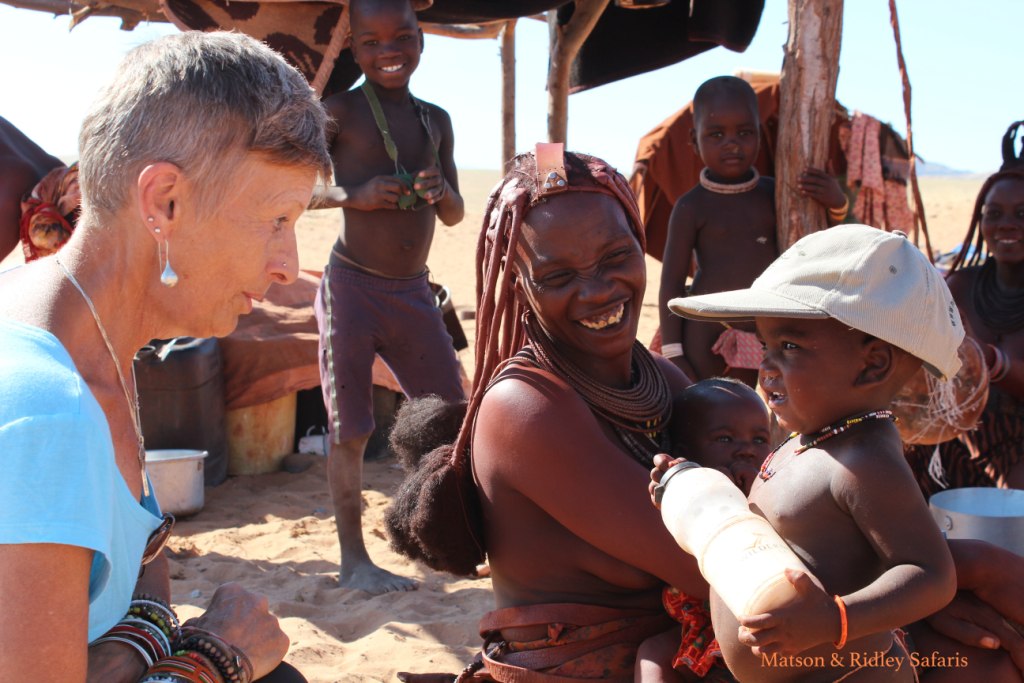 Interacting with the Himbas is really special and definitely a highlight of the visit. Here Maggie has a chat to a little Himba boy who clearly seemed to be enjoying the one-on-one, as mum watched on beside him with her young baby.
Interacting with the Himbas is really special and definitely a highlight of the visit. Here Maggie has a chat to a little Himba boy who clearly seemed to be enjoying the one-on-one, as mum watched on beside him with her young baby.
 I've always loved watching the Himba women with their small babies. The look on the mother's face above makes you think she could be any mother in the world. The 'midwife' who helps the women give birth is the old grandmother in the village. There are no medical doctors or hospitals out here.
I've always loved watching the Himba women with their small babies. The look on the mother's face above makes you think she could be any mother in the world. The 'midwife' who helps the women give birth is the old grandmother in the village. There are no medical doctors or hospitals out here.
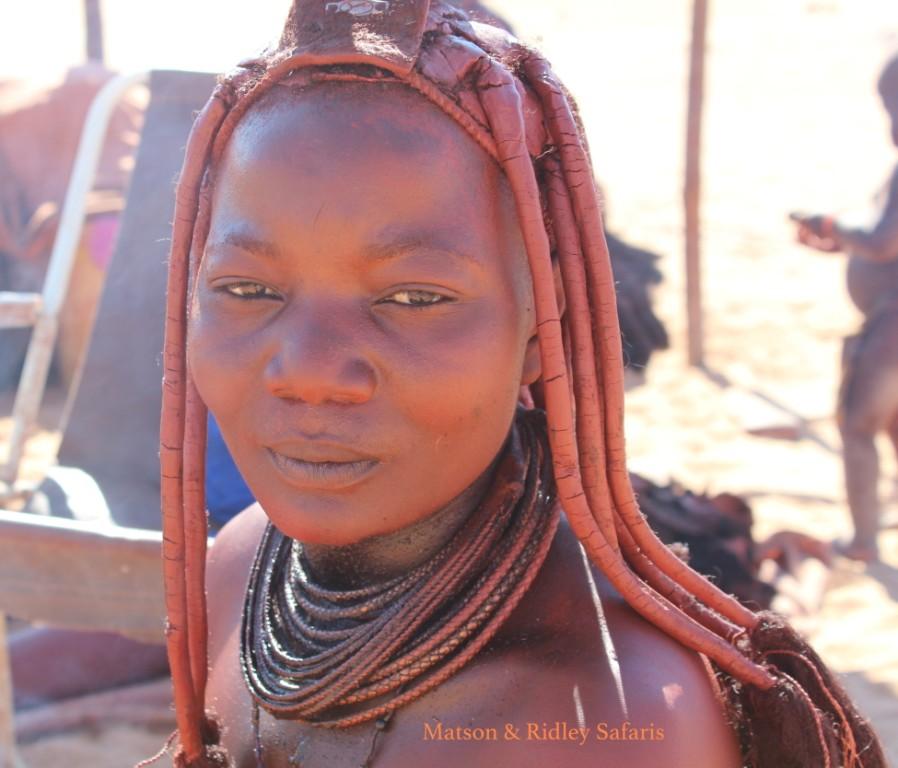 Women in Himba culture wear a special head dress if they are married. The red ochre that they cover their bodies with acts as a sunscreen and a moisturiser, but it's also there for beautification purposes. Himba society is polygamous; men can have several wives. Lets just say feminism hasnt hit Himba society yet and I dont think it will for a while!
Women in Himba culture wear a special head dress if they are married. The red ochre that they cover their bodies with acts as a sunscreen and a moisturiser, but it's also there for beautification purposes. Himba society is polygamous; men can have several wives. Lets just say feminism hasnt hit Himba society yet and I dont think it will for a while!
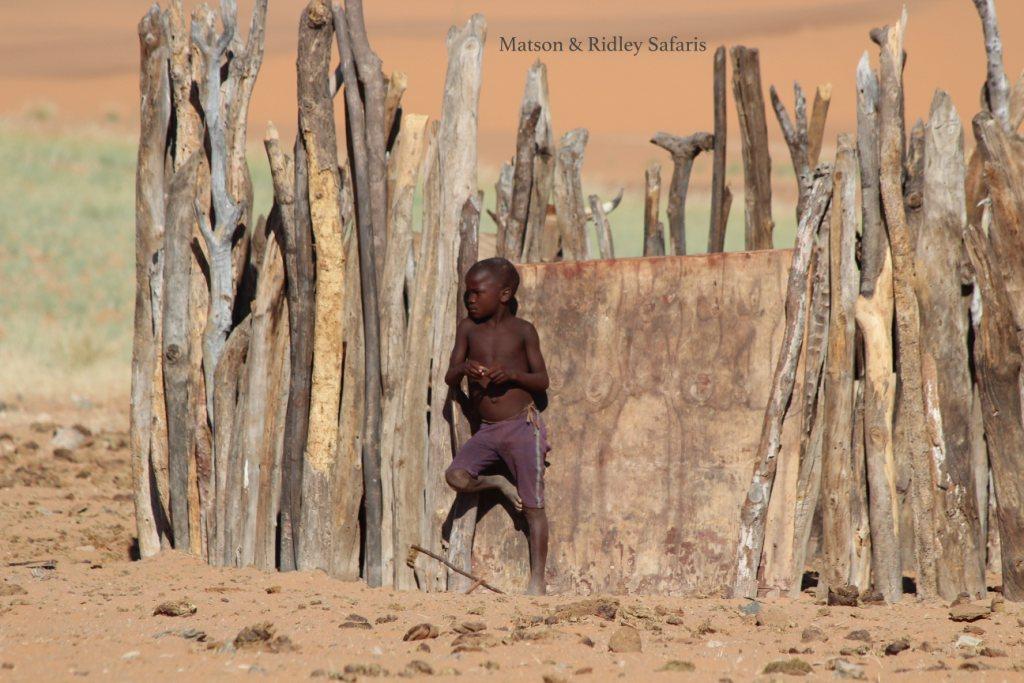 Some of the kids now go to school, but not all of them. Its easy to see how going to school could bring conflicts into the lives of these very traditional people, even though its important that they are represented and have their say in the country where they are a minority population-wise. Education is essential for this but it doesnt come without challenges. One of our guides, Stanley explained how he had been educated at a Christian school and this had created a conflict in him. Now that he believed in the bible because of his school, he explained, it was hard for him to feel okay with the Himba worship of the ancestors in the ancestral fire. The two didnt go together well. It was explained to us that the Himbas believe that when you die, you go into the ancestral fire and you are still there with the people, accessible through the fire, but not really gone. Im not sure Ive got that 100% right, but its certainly not a philosophy that sits too easily with Christianity. So I could see how bringing in modern ways of thinking from the outside world would be seen as a threat to Himba culture and tradition.
Some of the kids now go to school, but not all of them. Its easy to see how going to school could bring conflicts into the lives of these very traditional people, even though its important that they are represented and have their say in the country where they are a minority population-wise. Education is essential for this but it doesnt come without challenges. One of our guides, Stanley explained how he had been educated at a Christian school and this had created a conflict in him. Now that he believed in the bible because of his school, he explained, it was hard for him to feel okay with the Himba worship of the ancestors in the ancestral fire. The two didnt go together well. It was explained to us that the Himbas believe that when you die, you go into the ancestral fire and you are still there with the people, accessible through the fire, but not really gone. Im not sure Ive got that 100% right, but its certainly not a philosophy that sits too easily with Christianity. So I could see how bringing in modern ways of thinking from the outside world would be seen as a threat to Himba culture and tradition.
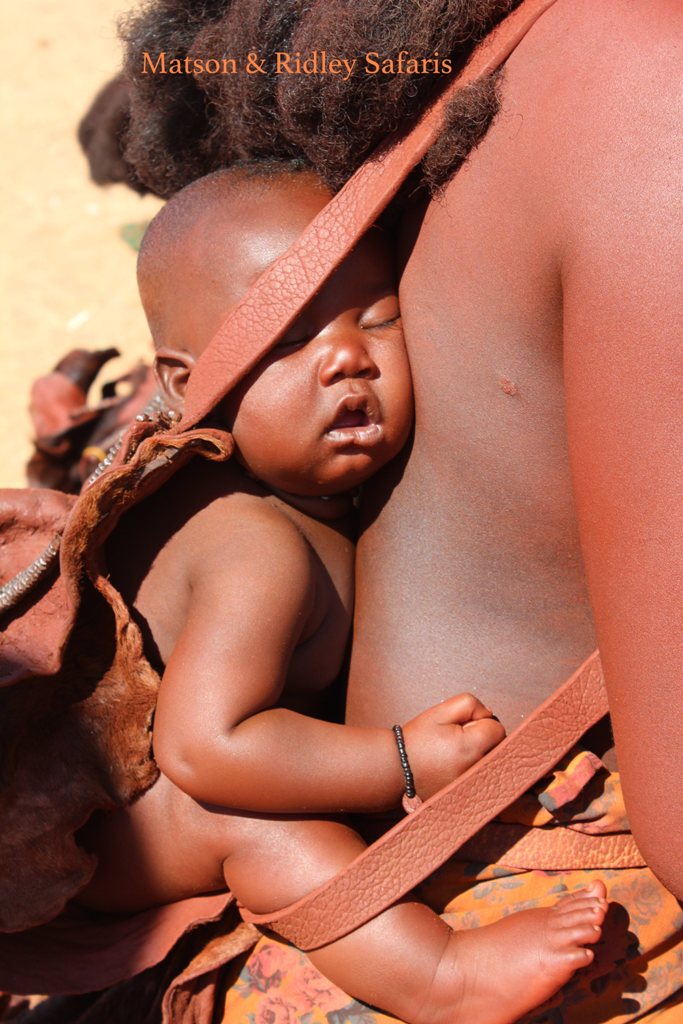 As soon as she strapped him onto her back, this baby fell right asleep. Mum resumed her work as if he wasnt even there!
As soon as she strapped him onto her back, this baby fell right asleep. Mum resumed her work as if he wasnt even there!
 The Himba women seemed thrilled to be able to sell some of their jewellery to our group. I think we made a good contribution to their small businesses!
The Himba women seemed thrilled to be able to sell some of their jewellery to our group. I think we made a good contribution to their small businesses!
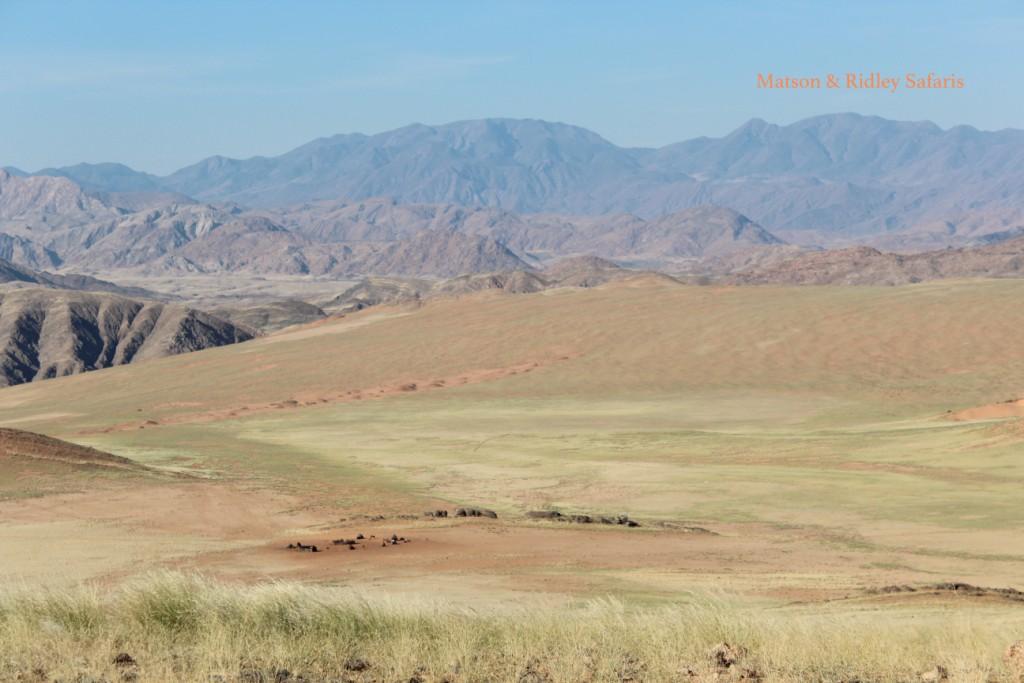 In the foreground in this picture you can see the Himba village. If only our own cities were as unobstructive in the landscape as theirs! Thats the hills of Angola in the background.
In the foreground in this picture you can see the Himba village. If only our own cities were as unobstructive in the landscape as theirs! Thats the hills of Angola in the background.
 One of the fun adventure activities you can do at Cafema is hop on a quad bike and explore the landscapes from behind the wheel of your very own crazy demon 4x4. Heres Helen just as we were about to take off. For some of my group, this was the first time on a quad bike. They are easy to use and dont take long to get the hang of. Its an awesome way to explore the area, and a whole lot of fun too!
One of the fun adventure activities you can do at Cafema is hop on a quad bike and explore the landscapes from behind the wheel of your very own crazy demon 4x4. Heres Helen just as we were about to take off. For some of my group, this was the first time on a quad bike. They are easy to use and dont take long to get the hang of. Its an awesome way to explore the area, and a whole lot of fun too!
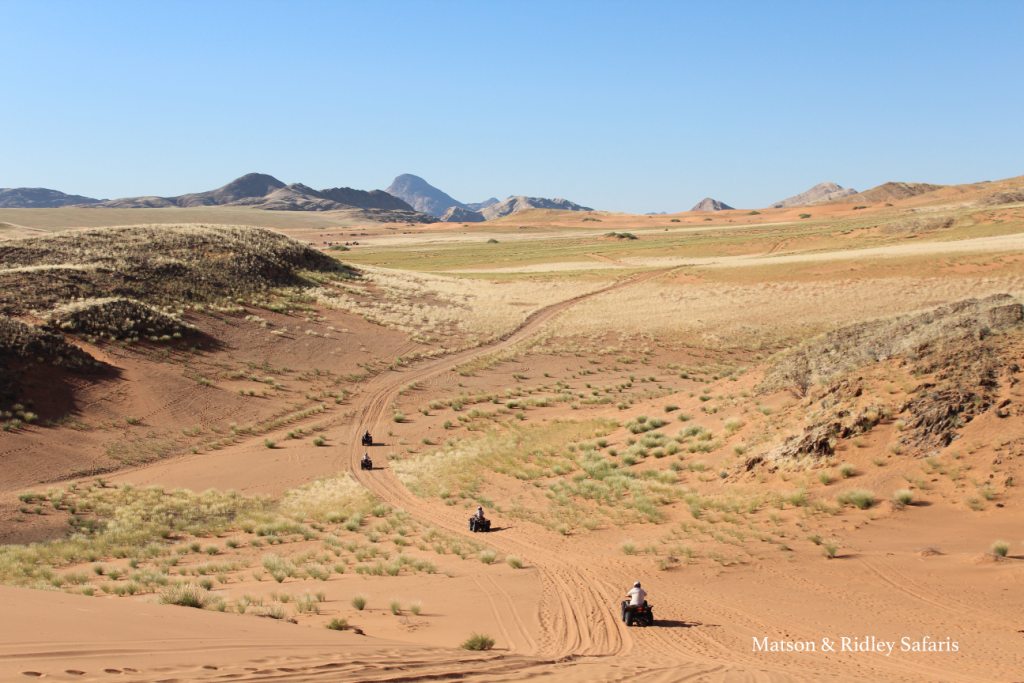 On the last morning, after a special request from Helen, those of us who wanted to were able to quad bike our way all the way to the airstrip. What a thrill this was! One of the most incredible things was watching hundreds of springboks congregated on the plains running through the grass as we drove by. Absolutely unforgettable.
On the last morning, after a special request from Helen, those of us who wanted to were able to quad bike our way all the way to the airstrip. What a thrill this was! One of the most incredible things was watching hundreds of springboks congregated on the plains running through the grass as we drove by. Absolutely unforgettable.
 Well of course I have many more photos but there are way too many to share here. Serra Cafema is one of those places that you have to see to believe. Like Maggie kept saying as we drove in from the airstrip, "This is just mad!" and it really is hard to believe such a landscape exists in the modern day. Its getting harder and harder to find these truly wild places. Of course its not without its human impacts, but the Himbas are part of this environment and custodians of the land. As the landlords of the Marienfluss Conservancy and Serra Cafema Camp, its up to them to conserve this region, their home. By going there to visit, we all contributed to their livelihoods through ethical tourism, and with the potential threat of the government building a dam on the Kunene that would flood part of the region, the income and jobs that Serra Cafema provide are essential to the future of this area. I cant wait to go back.... I think Chuan Fong summed it up best when we were standing on a mountain overlooking the Kunene on the last day: "This makes me happy."
Well of course I have many more photos but there are way too many to share here. Serra Cafema is one of those places that you have to see to believe. Like Maggie kept saying as we drove in from the airstrip, "This is just mad!" and it really is hard to believe such a landscape exists in the modern day. Its getting harder and harder to find these truly wild places. Of course its not without its human impacts, but the Himbas are part of this environment and custodians of the land. As the landlords of the Marienfluss Conservancy and Serra Cafema Camp, its up to them to conserve this region, their home. By going there to visit, we all contributed to their livelihoods through ethical tourism, and with the potential threat of the government building a dam on the Kunene that would flood part of the region, the income and jobs that Serra Cafema provide are essential to the future of this area. I cant wait to go back.... I think Chuan Fong summed it up best when we were standing on a mountain overlooking the Kunene on the last day: "This makes me happy."
